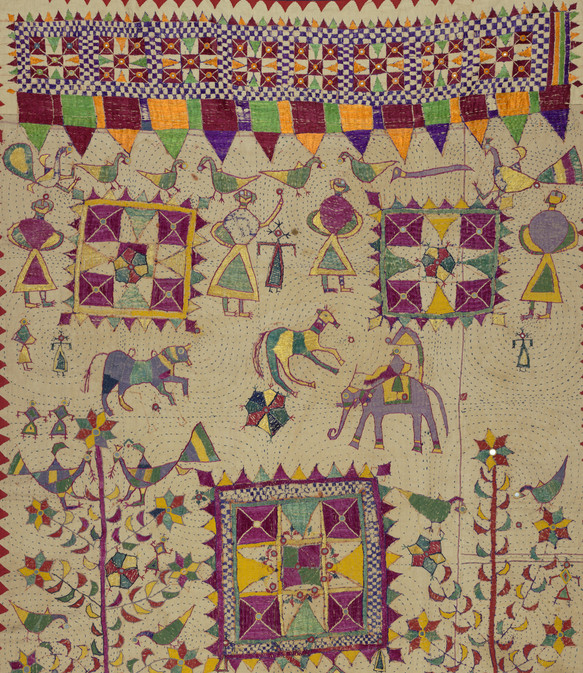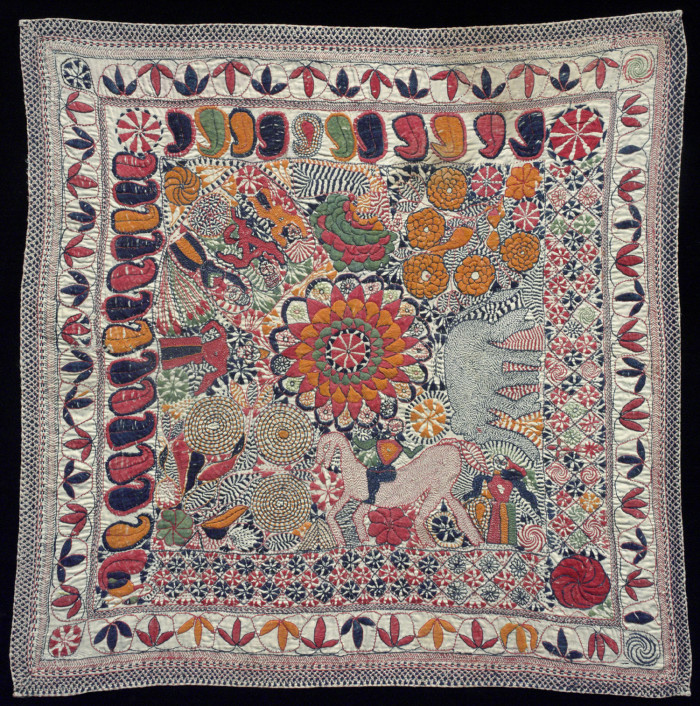Kantha is the practice of reinventing worn cotton fabric into household textiles. The craft is indigenous to the Bengal region of South Asia and is now practiced in Bangladesh, and the Bihar, West Bengal, and Odisha regions in India. In Bengali households, old sari fabric is stripped of embellishments and transformed into winter blankets. Smaller scraps can be designed into everyday textiles, like a gilaaf (book cover), bostani (wrapper for clothes), bolisher oshar (pillow cover), or dastark (a long floor placemat for food). Along with these possibilities, artisan employed by NGO enterprises, like Aarong and Arshi, design ornamental quilts called Nakshi kantha, the most celebrated kantha form and a quintessential element of Bengali decoration.

Kantha cloth (India), c. 18th-19th century; cotton, embroidered in silk, appliqué, mirror inserts; 185 x 116 cm (73 x 46 in.); 1965-48-01
Some from the older generation of Bengali women, who were trained in sewing kantha, still make DIY blankets as a hobby and to sell commercially. Sewn from the cloth of old saris, the worn cotton fabric is not only economical, but also makes soft and comfortable quilts. Borders of old saris are torn and used as is for the borders of kantha quilts and threads can be drawn from the cloth to stitch motifs. Pieces of cloth are stacked on top of each other and then hand-stitched.
Historically, kantha textiles have used a form of the running stitch, called the kantha stitch. It consists of a line of small and even stitches running through the cloth without overlap. The simplicity of the kantha stitch is organic to the objective: to repurpose old clothing into new products without wasting resources.
Contemporary textile designer Hibah Rahmani, who uses kantha work, writes:
“Growing up in a Bihari household and having it come through in my textile work is an amazing feeling. I feel proud to be able to use these traits in my work. I’m inspired by a lot of nature in my kanthan and sujani embroidery work. I use a lot of flowers and plants as my inspiration. Bright vibrant colors that will catch your eye. I want people to be able to look at my work and feel a rush of joy from all the colors. Their eyes glued to all the detailed embroidery and pattern work.”

Kantha (Embroidered Quilt), Bengal, Second half of 19th century, Cotton plain weave with cotton embroidery in back, chain, darning, satin, running, dot, and seed stitches, Philadelphia Museum of Art: 1968-184-12. Gift of Stella Kramrisch, 1968
Further Resources
Threads: The Art and Life of Surayia Rahman. Directed by Cathy Stevulak. Produced by Cathy Stevulak and Leonard Hill. 2015. See: trailer.
Zaman, Niaz. The Art of Kantha Embroidery. Dhaka: University Press Limited, 1981.
About the Author
Shahzeen Nasim was a summer 2016 Peter Krueger curatorial intern in Textiles at Cooper Hewitt, Smithsonian Design Museum.
Scraps Stories
This post is part of the blog series Scraps Stories dedicated to exploring sustainable textiles and fashion, in relation to the exhibition Scraps: Fashion, Textiles, and Creative Reuse.